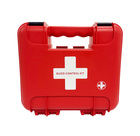Types of Shock
Unlock This Video Now for FREE
This video is normally available to paying customers.
You may unlock this video for FREE. Enter your email address for instant access AND to receive ongoing updates and special discounts related to this topic.
Types of Medical Shock and Symptoms
Introduction to Shock
Shock in medical terms refers to inadequate blood flow to the body's tissues and organs, which can result in cellular damage.
Types of Medical Shock
Hypovolemic Shock
Cause: Significant fluid or blood loss from trauma, dehydration, or severe internal bleeding.
Effects: Drop in blood pressure and reduced oxygen delivery to organs.
Cardiogenic Shock
Cause: Ineffective pumping of blood by the heart, often due to severe heart attacks, heart failure, or certain arrhythmias.
Effects: Inadequate blood supply despite normal blood volume.
Septic Shock
Cause: Severe infection, typically bacterial, leading to widespread inflammation.
Effects: Decreased blood pressure and impaired blood flow to organs.
Anaphylactic Shock
Cause: Severe allergic reaction to allergens like foods, insect stings, or medications.
Effects: Vasodilation, fluid leakage from capillaries, and consequent low blood pressure.
Neurogenic Shock
Cause: Spinal cord injury, particularly at the cervical or thoracic level.
Effects: Widespread vasodilation and decreased blood pressure due to nervous system imbalance.
Obstructive Shock
Cause: Physical obstruction preventing heart filling or pumping effectively.
Examples: Tension pneumothorax, cardiac tamponade, pulmonary embolism.
Effects: Impaired blood circulation and reduced oxygen delivery to tissues.
Symptoms of Shock
Common symptoms across all types of shock include:
- Clammy or bluish skin
- Rapid heartbeat
- Shallow breathing
- Nausea
- Confusion
- Decreased urine output
Emergency Response
If someone shows signs of shock, it is crucial to seek emergency medical attention promptly for appropriate treatment.



_-Trauma_8x20_CE.jpg)


_-Trauma_10x10_CE.jpg)
